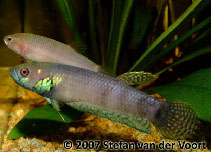| Family: |
Osphronemidae (Gouramies), subfamily: Macropodusinae |
| Max. size: |
6.63 cm SL (male/unsexed) |
| Environment: |
benthopelagic; freshwater |
| Distribution: |
Asia: upper Barito in Kalimantan Tengah, Indonesia. |
| Diagnosis: |
Dorsal spines (total): 0-1; Dorsal soft rays (total): 6-9; Anal spines: 1-2; Anal soft rays: 26-31. Differs from the other members of the Betta unimaculata group by the following combination of characters: hyaline subdistal band on anal and caudal fins of female; lanceolate caudal fin in adults; body brownish; lower half of caudal fin with dark distal edge; vertebrae 31-33 (mode 32); anal-fin rays 27-32 (mode 30); dorsal-fin rays 7-9 (mode 8); pectoral fin rays 11-14 (mode 13); subdorsal scales 5 - 6 1/2 (mode 6): lateral scales 32-34 (mode 33); predorsal scales 21-26 (mode 23); predorsal length 64.6-69.4% SL; head length 26.8-33.4% SL; length of anal-fin base 47.4-57.7% SL; length of dorsal-fin base 9.3-12.5% SL; lower jaw length 30.6-39.6% HL (Ref. 56613). |
| Biology: |
Found in headwater habitats (Ref 56613). Probably a paternal oral-brooder (Ref. 56613). |
| IUCN Red List Status: |
Data deficient (DD); Date assessed: 28 December 2018 Ref. (130435)
|
| Threat to humans: |
harmless |
Source and more info: www.fishbase.org. For personal, classroom, and other internal use only. Not for publication.
